Can We Collage on Art Mounting Boards Without Warping?

Sheet prints don't have to be stretched. Hither are some instructions on how to mount sheet prints.
When printmakers call back about canvas, they tend to think about stretching.
For a list of oftentimes asked questions please click hither
This traditional procedure requires that the printmaker either pays someone to stretch the canvas for them, or takes on the grooming to learn how to stretch.
It is possible, nevertheless, to produce sail prints which can can exist turned into cute framed prints without stretching. And, because canvas doesn't have the aforementioned needs as a newspaper impress, it tin can be displayed without any glazing (drinking glass) for an heady, unique look:

This process is done with a wet mountain of a coated canvas to a substrate such every bit gator board. In the photo to a higher place you can run into a 28″ x 28″ sail print that was mounted to gator and has been framed.
What is Gator board and why not but use foam cadre?
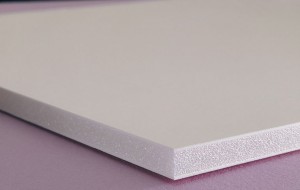
Gator board has a much more durable surface, and tin take a wet mountain without harm.
By design, gator is very stiff and comes in diverse thicknesses. I cull to piece of work with three/sixteen″ and 1/2″ for my work. Gator will not deform over time and will resist bending and due to the stiff nature of the product it will not prove whatsoever rippling when the canvas is mounted.<
Foam cadre is not a cracking solution as information technology'southward much softer past pattern and will easily allow a pressure dimple or other blazon of damage to the print. Foam core as well will not piece of work well with a wet mounting type solution equally it will tend to split up and warp if it gets moist. Most foam core doesn't have a perfectly even surface and thus will not permit for a print to mountain well.
Getting Started
For this blazon of mount, you lot need to brand certain you take coated your canvas as the application involved a wet mounting procedure.
So if you are using Crystalline or any "glossy" canvas which is aqueous based, you lot can't allow whatsoever h2o to become on the face up of the sheet. If this happens, then the ink will more than probable wipe off equally you clean the print. For my piece of work, I utilize both Animate Color'due south 800M matte canvas and Crystalline. Earlier I get fix to mount, I volition coat the canvass with Breathing Color's Timeless glossy coating.
This volition protect the print during the mounting procedure and add years of protection to the impress.
Trimming the Canvas
Once I have the canvas coated, I volition trim it to the final size for mounting. I prefer to leave a 1/2 inch border on the canvas to allow easy handling of the sail during the mounting. Then I quickly make a set of tick marks around the print and trim it down to size. For example on a xx x 30 canvas, I will have a canvas that is 21″ x 31″ and I make the Gator board the aforementioned size. This means you practice take a bit of actress waste merely to me the extra is worth it since the 1/2 border means I have some room to handle the print without getting my fingers on the confront of the impress.
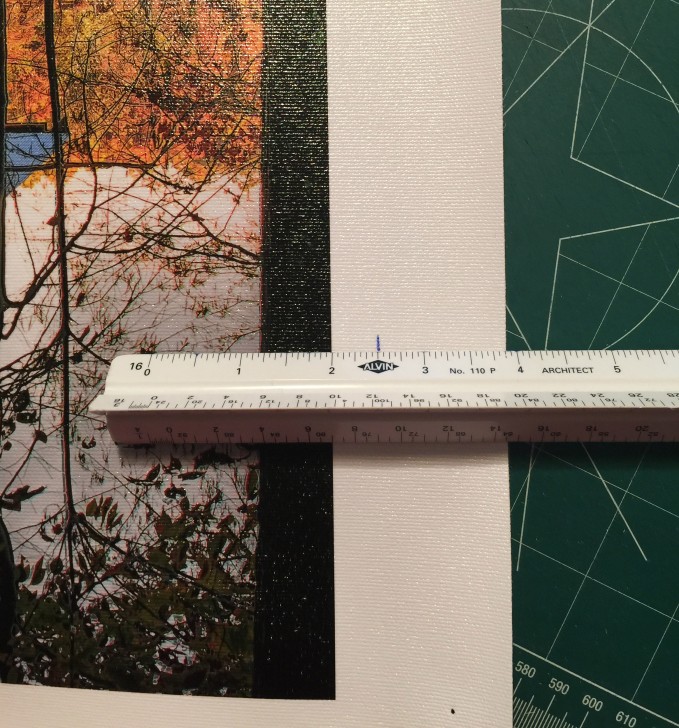

With the canvass trimmed, you are at present set to fix the gator board.
Preparing the board with gum
Gator comes in white or blackness. I apply black, only because I employ a white glue and it'south much easier to see the board with glue on it to brand sure you lot accept 100% coverage.
For our 20″ x 30″ print, which is still 21″ x 31″, I accept cut a 3/16 inch piece of gator to the same size of 21″ x 31″. I volition ever wipe off the gator with a damp rag. This helps to set the gum to the lath and remove any small particles that may exist sitting on top of the gator. And so I will lay out the glue. I apply a brand chosen Miracle Muck. This is a fast setting water based glue that has excellent adhesion properties.
For this process, I outset with two large spots of glue towards the center of the gator.
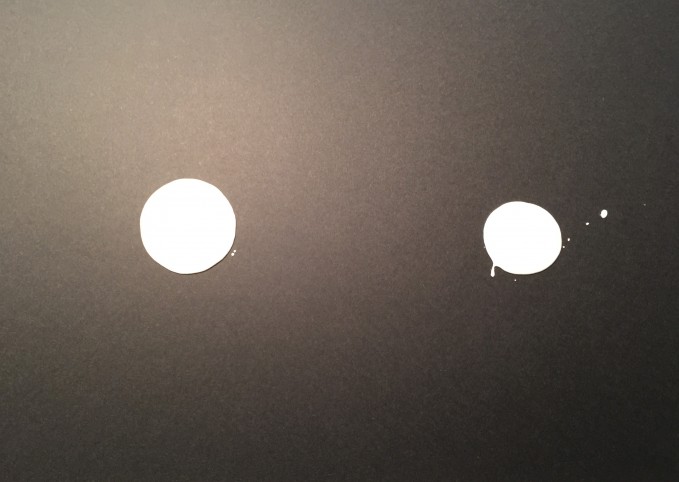
With a soft burnishing brush, I will then start to layout the glue evenly across the gator. While doing this, yous want evenly distribute the glue beyond the face of the gator board. I tend to make a serial of passes, going up and downward and so across the confront of the gator board.

I use a standard iv inch print maker's roller to layout the mucilage. This roller has a soft gum safety finish, non a hard 1. I prefer the 4 inch roller for all sizes of gator lath every bit I feel I get better control over the distribution of the mucilage. When you are finished rolling, brand sure you have the roller to the sink and launder off the glue as it volition start to set quickly.

Before we go to the mounting of the sheet, allow me briefly talk about the tools I use. In this image yous can run into a close up of the 2 rollers I use and the soft tack/lint free rag.
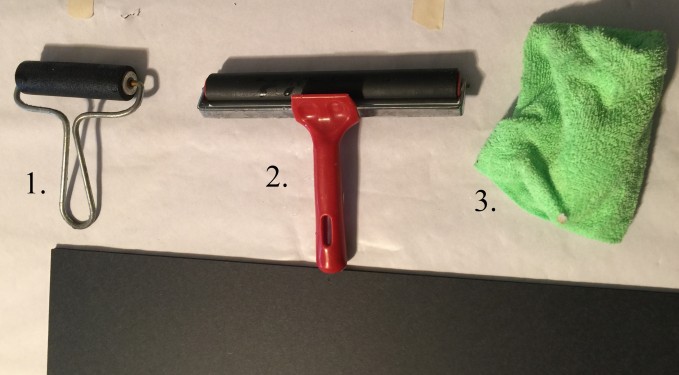
-
- The soft roller is fabricated from black gum rubber and is found in most art supply stores. It'due south called a burnishing brush and most commonly used in lithography and print making. I take establish it to be indispensable for the process of rolling out the glue. Y'all tin selection these up in various widths simply I prefer the iv inch size for all my piece of work. Over fourth dimension the material of the roller will harden and cleft, and then expect to replace this roller in a year or so.
-
- This detail is a hard roller and I use this once the impress has been placed on the glue prepared gator board surface. This roller is around 8 inches wide applies a nice even pressure level to the confront of the canvass to make certain all the air bubbles have been removed. The key to this type of roller is the metal frame. Make certain y'all get one with a stiff frame that won't bend, or the roller will bind up under force per unit area.
- The terminal item is a lint costless soft rag, most unremarkably found in a car parts store. In the process of mounting I will use this rag many times. To help lay down the canvas then to make clean up any excess glue that might have slipped up to the face of the canvass. You desire to apply this rag clammy, every bit a dry rag may lightly scratch the confront of your canvas.
Mounting the Canvas
As soon as y'all have the gator board covered with glue, you want to start the mounting procedure. This is the virtually disquisitional office then accept some practice runs on smaller prints, earlier you lot effort to mount an epitome larger than 16″10 20″. The mucilage I utilize has a working time of about v minutes, afterwards that, if you don't have the print downward flush, you will need to pull the impress off, and re-lay downward your gum. Think back when I offset trimmed the print, I left a 1/2 inch edge. This allows you a flake of room for errors and more than importantly, you tin can choice up the print without worry of getting your a gum print on the face up.
Now that nosotros're prepped and have the right tools, we're ready to mountain the canvas.
1. Take the impress and ringlet it up so the side to be mounted is outside. So line one of the edges of the canvas to the gator board edge. Information technology'due south much easier to work with the print rolled up than trying to lay it down in 1 big stride.

2. With your damp rag, on the face up of the print (Notation: if you lot are using a glossy canvas, y'all must coat it kickoff) unroll the print and at the same fourth dimension use some low-cal force per unit area to the face up of the print. With one mitt control the roll of the impress and with the other smooth out the print over the gator board.
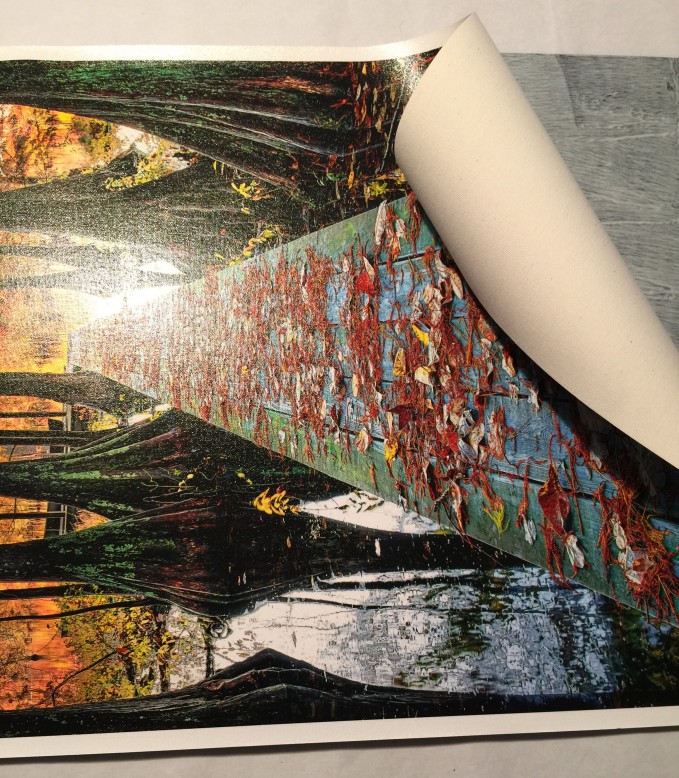
3. Once y'all accept the print all the manner rolled out, have your hard burnishing roller and starting time at one end of the print and curl across the confront of the impress. Apply a considerable amount of pressure during this step every bit you lot will non hurt either the print or the gator. Again this volition take time to get the hang off. Merely this footstep is very disquisitional as you lot don't desire any air left under the canvas. Once you lot have finished, have you lot damp rag and wipe over the confront of the print just to feel for any bumps. This is more important on a large print of 24″ x 36″ or larger.

4. Once you feel the impress is downwards evenly, pick up the gator board and concord the mounted print in the low-cal at an angle and expect for whatsoever bumps or problems on the face, as now is time to go them out. If you run across some trapped air, merely get your damp rag and work it out. It y'all come across a piece of trash, you will need to pull the print back, remove the debris and and so re-brighten.
If you do this inside the showtime 5 to vi minutes the glue will still set, but if wait whatever longer, you may need to re-apply some glue on the board. Also look to see that y'all don't get some gum on the impress or take wiped a bit of done down glue over the confront of the impress. This is piece of cake to get off at present, but adjacent to incommunicable once allowed to dry.
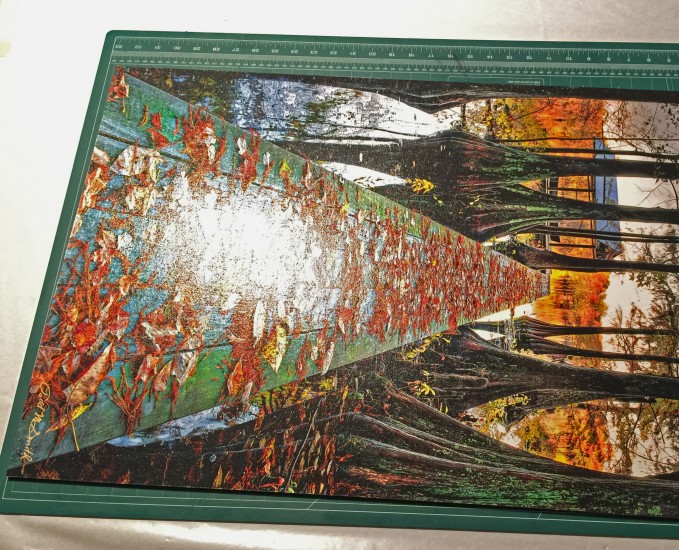
5. When yous are done, you print should look like this. You may see that the gator board has bowed upwardly due to the moisture, but don't worry every bit during the drying process this will all come out. Plus since the mounted print is going in a frame, if y'all run across a bit of bowing even so after drying, practice not worry as the frame itself will even the print out.

Do a quick check on the back of the print to make certain you don't have any globs of mucilage at that place. This is but a nice manner to finish the piece front and dorsum.
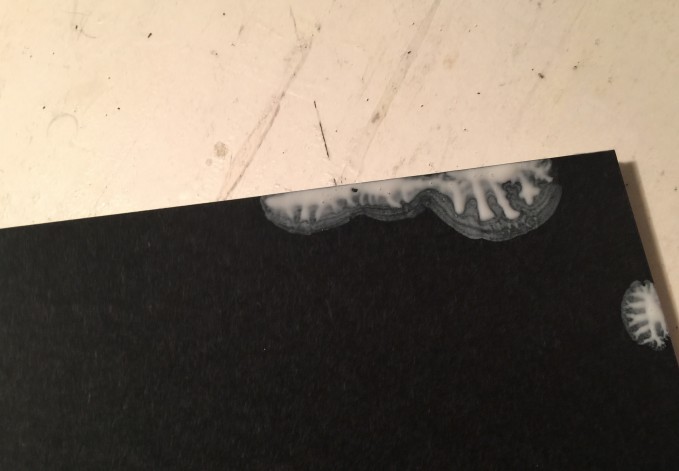
If the print is a 20 x thirty or larger, I like to identify some weight on the face up of the impress while it dries, just to assistance keep the bowing to a minimum.
I like to let the prints dry overnight, but if yous are in a push you lot should be to trim the piece after about 6 hours. Just take you finger and pull back on the edge and see if in that location is whatever play with the canvas. It should totally resist any attempt to pull it back if the mucilage has dried.
Trimming the Finished Board
At present all that is left is the trimming, and this tin can too be a scrap catchy. Gator board is much stiffer than foam core and fifty-fifty 3/16 inch will crave several cuts. What I like to do is use a ruler, lined up on the white border, and using fresh blade in an olfa paw cutter make my cuts.
These cutters have a segmented single blade and you can hands break off the dull tip and keep on cutting. You don't want to to use a blade on too many cuts equally gator lath will dull a blade quickly. The process I like to use is as follows:
1. Line upwards the straight border along the white edge, and make your cutting all in one even pull. The first couple of passes will cut the sail and start to break into the gator board. I always brand sure to cutting into a cutting mat. These are designed to absorb the point of the bract and help you command the cut. Y'all can see the green cutting mat in the flick.

2. After you have made the cut down into the gator board, yous will commencement to see the smoothen way the gator lath has cut away and given yous a clean edge. If I am working on prints that I know are going into frames, I will go ahead and snap the gator board after 2 cuts. You can see in this picture as I am pulling the cutting gator board away which shows the clean cut.
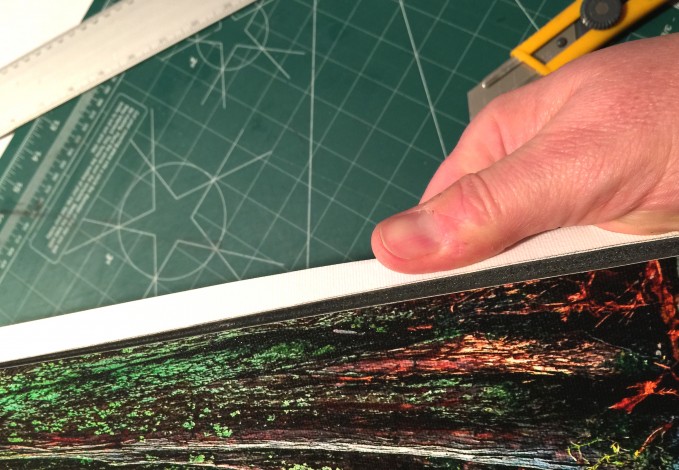
3. On a larger print, you may want to tape down the ruler, as it'southward easy to take the ruler motility just a flake every bit you movement down the print. On 20″ ten 30″ prints or larger I ever exercise this. There is nothing worse than getting all this piece of work washed upward to this point to have an errant blade cut into the print and ruin information technology. Accept your time on this part. Also be aware that cut gator board edges are very precipitous and by running you mitt over them, you can become a cut pretty rapidly.

The finished, mounted print is now set to put into a frame. I will oftentimes blacken the upper edge of the print as you tin see the white line of the canvass confronting the black of the gator.
This is a great way to get into sheet printing, and not have to focus on stretching. The finished product in a blackness frame is shown below.
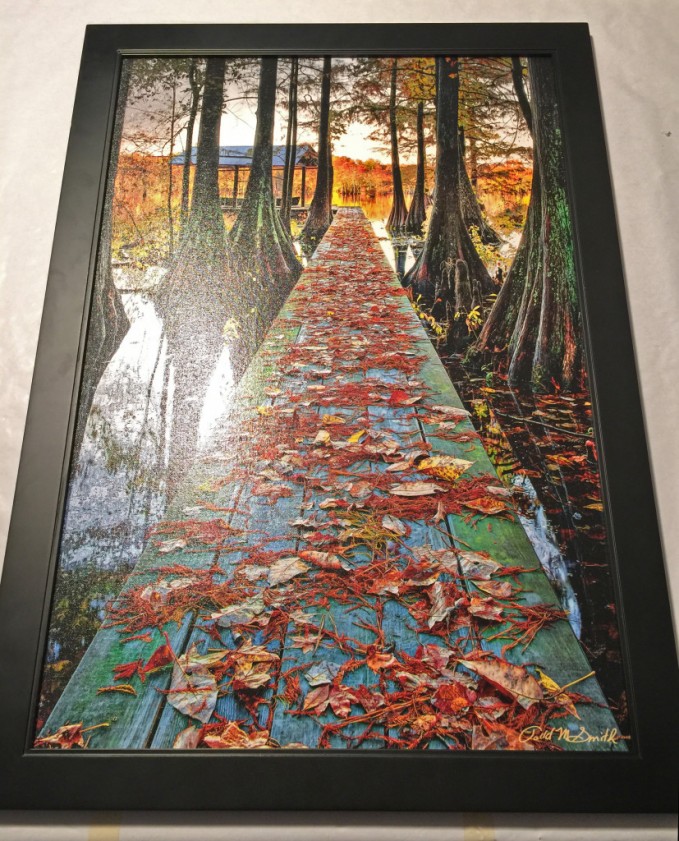
Have a question about mounting canvas prints that I didn't answer here? Get out information technology in the comments below.
For more information about Paul, and to check out some of his awesome photography visit photosofarkansas.com

Paul Caldwell has been working in the photographic arts since he was 15 and has been a professional photographer for the final 10 years. As you would imagine, Paul has a wealth of noesis when it comes to photography and printmaking. He sells some great looking prints on his website and offers ane-on-one classes covering everything from capture to impress.
Ofttimes Asked Questions
How do you mount a canvas impress?
You can mount a sheet print without stretching it. At that place are 2 techniques: moisture mounting and dry mounting. Moisture mounting means using a liquid agglutinative to adhere the canvas to a rigid substrate. Dry out mounting involves using a film laminate to stick the canvas to the rigid surface. When working with sail specifically, it is all-time practice to utilize the wet mountain method. If you are mounting a more smooth media, such as photograph paper, then dry mounting is mutual and often easier. With the wet mountain process, you basically mountain the canvas to Gatorboard (or MDF, or masonite, or some other rigid substrate) in order to give the finished piece its rigidity. Gatorboard is dense, durable, and relatively lightweight. This allows for a simple, impairment-gratis workflow as well as safe transport or shipping to the customer.
How exercise you hang a stretched canvas?
The easiest way to hang a stretched canvas without framing is a uncomplicated smash. Please annotation that often one boom will not suffice. Using two nails instead is a better idea. 1 for each corner for ultimate support. Utilize a ruler, a level, two 2 inch nails, and a pencil for this DIY project. Place the painting in the final position you would like it in. Employ a level to mark the top 2 edges of the print. Next, y'all want to remainder information technology with the level. Then mensurate i inch down from your markings and make 2 boosted marks. Make certain to utilise the level between the ii sides. The lower marks are for the nails. Hammer the nails leaving nearly half an inch (1/2″) protruding. For the concluding stride, rest the canvas on the nails. Voila, you're done.
Can I frame a canvas impress?
Short reply, yes you can frame a canvas print. A common reason to frame a impress is because of unsightly sides of the sail wrap. At that place are different ways to wrap your canvas. Methods include gallery wrap, museum wrap, and standard wrap. Gallery and museum wraps are ones that you would have no trouble hanging as is. The standard wrap is one that people would frame to hibernate the sides since it is not uncommon for a standard wrap to be stapled on the side of the stretcher bar instead of the backside. This is all personal preference but this is our experience from talking to both print makers and people who purchase printed art and photography.
How to frame a rolled canvas impress
Nosotros recommend that you lot accept i of two mutual paths: 1) stretch a rolled sheet yourself using a DIY system similar Breathing Color's EasyWrappe, or 2) take your rolled-up canvas print stretched for you. For this, y'all tin can use your local print shop or frame shop. Practice a Google search and and so telephone call around. You can frame your sheet a number of different ways offered in the market. You tin have the canvas stretched and so put into a canvas floater frame. Or frame it, every bit y'all would any other print, using a wood, metal, or even acrylic frame.
How much does it cost to frame a canvass impress?
There are a number of factors for pricing out a sheet frame. It tin can range from $8-$20 per linear foot. This comes out to around $50 to $150 per print or a lot more than depending mainly on the size of your print, stretcher bar thickness, and frame thickness. It is best to telephone call around for quotes.
Follow-Up Reading
If you liked this post, you'll love these related ones:
0 Response to "Can We Collage on Art Mounting Boards Without Warping?"
Post a Comment